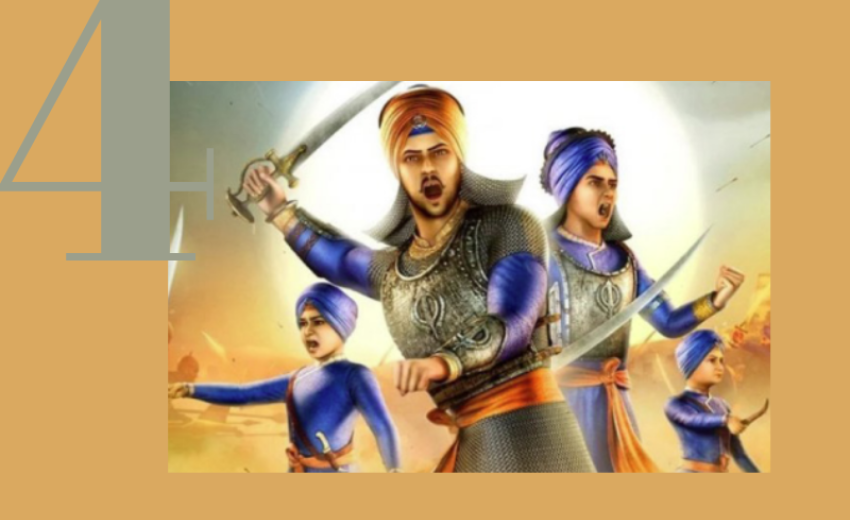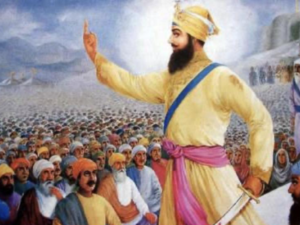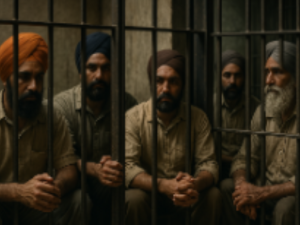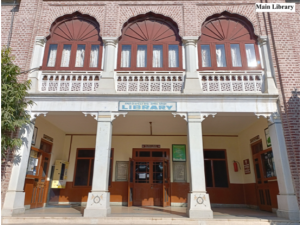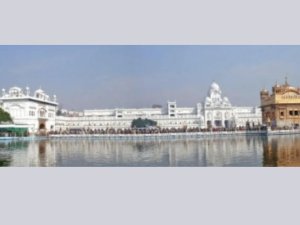In order to free the people of Hindustan from centuries-long slavery, both physical and mental, the tenth master, Guru Gobind Singh ji, not only led courageous struggles against the oppressive rulers of the time but also wrote a new chapter in the history of the concept of everlasting necessity. His determination, self-assurance, courage, and selfless spirit set the standard for unflinching combat in life's struggles for all future generations. Guru Sahib brought such a soul into the dead nation by performing sacrifices, deeds, and gifts at his young age that was truly an amazing charisma in the history of the world.
Anandpur Sahib had been besieged by Mughals, Pahari Rangers, and Gujars for eight months. The situation in Anandpur Sahib had become a very serious and painful one. The supply of water and rations in the fort was stopped by the enemy forces. There were about 460 Singhs, Singhanis, and innocent children inside the fort. Despite the pathetic condition, the Singhs inside the fort were maintaining high morale. They had to survive by eating the leaves of the trees. Even the Parsadi elephant gifted by Tripura Raja to Guru Gobind Singh ji had died of starvation. The situation became very challenging for the Singhs to survive and even engage in a fight with the fierce enemy that encircled the fort. The Singhs wanted to leave the Anandpur fort, and finally a consensus was reached to bid farewell to Anandpur Sahib.
On the one hand, the encirclement of the enemy forces, the scattered and terrible roads, the torrential rains, forests, the dark black night, and the mighty Sarsa River, and on the other hand, the determination, self-belief, iron will, and sacrifice of Guru Gobind Singh, turned the hopes upside down. About 460 Singhs, Mata Gujri ji, Chaar Sahibzades, Bibi Bhikhan, and Subhikhi were included in this caravan. This entire caravan was moving towards Kiratpur Sahib. While passing the turn from Kiratpur to Bilaspur and going towards the Sarsa River, a hilly (a resident of the hilly region) saw this caravan and informed the troops. The Singhs were informed that the mountain troops were coming near the village of Jhakkhian. On receiving this news, Guru Sahib gave strict instructions to the Warrior Singhs to take a special position. Bhai Uday Singh ordered 50 Singhs to march towards Shahi Tibbi. Bhai Jeevan Singh (Jaita) was instructed to set up a frontline of 100 Singhs on the banks of the Sarsa River. The third batch of one hundred (100) Singhs was under the command of Bhai Bachitar Singh to stop Nawab Sirhind's army from coming to Chamkaur. Guru Sahib instructed Bhai Uday Singh to inform Sahibzada Ajit Singh and Bhai Budha Singh that they should cross the Sarsa River and reach Bhai Nihang Khan's fort in Kotla village. During this time, Mata Gujri ji and the younger sons of Dashmesh Pita, his two servants Bhai Sunna Singh and Bibi Sabhikhi, crossed the Sarsa River and went to Chamkaur. Gangu Brahmin (cook) took Mata Gujri ji and two younger Sahibzades to his village, Saheri (Kheri). A handful of Singhs fought bravely in 'Chamkaur Di Garhi, in which 37 Singhs along with two Vade Sahibzades were martyred. Guru Sahib and Panj Singh remained in the fort till nighttime (December 7, 1705).
Sahibzada Ajit Singh Ji:
Sahibzada Ajit Singh (1687-1705) was born to Mata Sunder Kaur and Guru Gobind Singh at Paonta Sahib. Sahibzada Ajit Singh and Sahibzada Jujhar Singh are remembered as 'Vade Sahibzade' in Sikh history. Sahibzade Ajit Singh was very intelligent, gifted with Gurbani, and agile from his childhood. At an early age, he mastered horseback riding and gun shooting. On May 23, 1699, while commanding a group of one hundred Singhs, he successfully raided the nearby village of Ranghars, who had once plundered the company of Pothohar Sikhs coming towards Anandpur Sahib. On March 15, 1700, he attacked the Gujars of Bajrur village, who once robbed the caravan of Singhs. On August 29, 1700, when the hill kings attacked the Taragarh fort, Sahibzada Ajit Singh bravely defeated the attack along with the Singhs. Similarly, in October 1700, again, the mountain forces attacked Nirmohgarh. Sahibzada took the lead, fought vigorously, and killed many hilly soldiers. Once, Dwarka Das Brahmin's wife was taken away by the ruler of Bassi Kalan. On March 7, 1703, along with Bhai Uday Singh, Sahibzada and a group of one hundred (100) Singhs rescued the wife of a Brahmin from Basi Kalan and handed her over to the Brahmin. Sahibzada Ajit Singh spent most of his life on the land of Anandpur Sahib. In May 1705, when Anandpur Sahib was besieged by a coalition force of Hill Cheiftians and Mughal forces, he was also there. Both the elder Sahibzadas were with their father while leaving Anandpur Sahib. When forty Singhs fought a fierce battle in the fort of Chamkaur, Sahibzada Ajit Singh went to the battlefield with Singh spirit, showed his bravery, and killed many Enemies. "Gur Sobha" testifies to this. Sahibzada Ajit Singh's total age at the time of martyrdom was 18 years, 11 months, and 19 days.
Sahibzada Jujhar Singh Ji:
Sahibzada Jujhar Singh (1691-1705) was born to Guru Gobind Singh and Mata Jit Kaur at Anandpur Sahib. Like his elder brother, he too was very intelligent, Gurbani- oriented, and skilled in horseback riding and archery. When Guru Sahib left Anandpur Sahib, he was also a companion. During the war of Chamkaur, he demonstrated his unwavering bravery and skill in a face-to-face fight with enemy forces. Before achieving martyrdom, he fought fiercely and killed many soldiers of the Mughal forces. Such a great personality was Guru Gobind Singh ji that before the start of the battle, he himself introduced both the Sahibzadas to the tradition of martyrdom. The Battle of Chamkaur was fought between the Khalsas and the joint forces of Mughals and hill chieftains of Shivalik Hills. It started at noon and continued until sunset. Guru Sahib has also mentioned this battle in his historical letter in Farsi, 'Zafarnama' or "Epistle of Victory," addressed to Aurangzeb. The details of this battle are also found in 'Bhattvahi Multani Sindhi". By evening, only five Singhs were left in this battle. A council of Punj Pyaras was convened and performed Gurmata to order the Guru Sahib to leave the fort (kachi garhi) with three Singhs. The next morning, December 8, 1705, the remaining two Singhs, Bhai Sant Singh and Bhai Sangat Singh achieved martyrdom fighting the Mughal forces. Thus, the Battle of Chamkaur, fought between 40 odd Singhs and ten lakhs of coalition forces led by the Mughals, remained the most unparalleled battle ever fought.
Sahibzada Zorawar Singh Ji:
Sahibzada Zorawar Singh (1696-1705) was born at Anandpur Sahib to Mata Jit Kaur and Guru Gobind Singh. From an early age, like his elder brothers, he too had a compelling learning spirit. When Guru Sahib decided to leave Anandpur Sahib, both the younger Sahibzadas, Baba Zorawar Singh and Baba Fateh Singh, were also travelling with them and were in the care of their grandmother, Mata Gujri ji. During the turbulent-dark night at the bank of the Sarsa River, they got separated from the main jatha, and on the way, they happened to meet their former cook servant, Gangu, who had been discharged from Guru Gobind Singh's household. Gangu took Mata Gujri and the younger Sahibzades to his village, Saheri (Kheri), near Morinda. He sheltered them in his house. In the night, when Mata Ji and Sahibzades fell asleep, Gangu searched their belongings and stole valuables. In the morning, when Mata ji raised the issue with Gangu, the greedy Gangu became angry and protested his innocence, who later got them arrested at the Kotwal of Morinda, and from there they were sent to the court of Subedar Wazir Khan of Sirhind.
Sahibzada Fateh Singh Ji:
Sahibzada Fateh Singh (1699-1705) was born to Mata Jit Kaur and Guru Gobind Singh at Anandpur Sahib. Fateh Singh was one year and ten months old at that time of the demise of his mother. So the upbringing of these two young heroes was approved under the care of their Grandmother. At Sirhind, despite the chilly winter weather, they were kept as royal prisoners in an open, cold tower (Thanda Burj). From here, start the mental and physical torture of the innocent sahibzadas. First, they were offered to convert to Islam, with promises. When they stood firm to their religious beliefs and flatly refused to convert to Islam, tactics of torture and threats were used on them. But both the Sahibzadas, aged 9 and 7, did not bow to any threat to their lives. Finally, Subedar Wazir Khan, on the advice of Diwan Sucha Nand, and the Quazi passed the order of killing the innocent Sahibzadas by bricking them alive in a wall. It is said that during the court proceeding, the Nawab of Malerkotla, Nawab Sher Muhammad Khan, stood in protest against the gruesome order of the Subedar. On December 12, 1705, both the Sahibzadas were bricked alive in a wall, and when the walls came up on their shoulders, they were killed by cutting their heads. Mata Gujri Ji was also tortured and killed in the cold tower by the subedar's soldiers. A merchant in Sirhind Diwan Todar Mal paid a heavy price in gold coins to purchase the land where Sahibzadas were cremated; it is considered to be the most valuable land in the history of the world.
At the site of cremation now stands a glorious Gurdwara, Gurdwara Fatehgarh Sahib, where thousands of devotees pay their obeisance to the youngest martyrs.
Finally, I would appeal to our younger generation to draw some inspiration from the glorious martyrdom of the four Sahibzadas, the real heroes, who stood tall in the face of horrific circumstance and did not waver in Dashmesh Pita Guru Gobind Singh ji has sacrificed everything he has on his beloved KHALSA, and declared us as HIS very own
Khalsa Mero Roop Hai Khaas,
Khalse mey ho(n) karo(n) Niwaas.
Khalsa ji, let us strive to be His very own, by following gurmat values, and enjoy his blessings!
